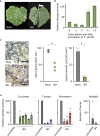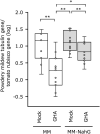Entomopathogenic fungus Beauveria bassiana-based bioinsecticide suppresses severity of powdery mildews of vegetables by inducing the plant defense responses
- PMID: 37692425
- PMCID: PMC10484095
- DOI: 10.3389/fpls.2023.1211825
Entomopathogenic fungus Beauveria bassiana-based bioinsecticide suppresses severity of powdery mildews of vegetables by inducing the plant defense responses
Abstract
The entomopathogenic fungus Beauveria bassiana is used commercially as a microbial insecticides against a wide range of agricultural insect pests. Some strains of B. bassiana protect the plants from pathogens, but the underlying mechanisms are largely unknown. Here, we found that prophylactic sprays of commercial bioinsecticide Botanigard on cucumber, tomato, and strawberry plants suppressed the severity of economically damaging powdery mildews. On leaf surfaces, hyphal elongation and spore germination of cucumber powdery mildew, Podosphaera xanthii, were inhibited, but B. bassiana strain GHA, the active ingredient isolated from Botanigard, only inhibited hyphal elongation but had no effect on spore germination of P. xanthii. In addition, strain GHA suppressed powdery mildew symptoms locally, not systemically. Treatment with Botanigard and strain GHA induced a hypersensitive response (HR)-like cell death in epidermal cells of the cucumber leaves in a concentration-dependent manner and inhibited penetration by P. xanthii. Transcriptome analysis and mass spectrometry revealed that GHA induced expression of salicylic acid (SA)-related genes, and treatment with Botanigard and GHA increased the SA level in the cucumber leaves. In NahG-transgenic tomato plants, which do not accumulate SA, the biocontrol effect of tomato powdery mildew by GHA was significantly reduced. These results suggested that B. bassiana GHA induces SA accumulation, leading to the induction of HR-like cell death against powdery mildew and subsequent suppression of fungal penetration. Thus, Botanigard has the potential to control both insect pests and plant diseases.
Keywords: Podosphaera xanthii; biocontrol agent; biofungicide; dual control; endophyte; induced resistance; plant-microbe interaction; salicylic acid.
Copyright © 2023 Iida, Higashi, Nishi, Kouda, Maeda, Yoshida, Asano, Kawakami, Nakajima, Kuroda, Tanaka, Sasaki, Kamiya, Yamagishi, Fujinaga, Terami, Yamanaka and Kubota.
Conflict of interest statement
Author SY is employed by the company Arysta Life Science Corporation. The remaining authors declare that the research was conducted in the absence of any commercial or financial relationships that could be construed as a potential conflict of interest.
Figures





Similar articles
-
Epiphytic and endophytic colonisation of tomato plants by the entomopathogenic fungus Beauveria bassiana strain GHA.Mycology. 2020 Jan 5;12(1):39-47. doi: 10.1080/21501203.2019.1707723. Mycology. 2020. PMID: 33628607 Free PMC article.
-
Biological control of the cucurbit powdery mildew pathogen Podosphaera xanthii by means of the epiphytic fungus Pseudozyma aphidis and parasitism as a mode of action.Front Plant Sci. 2015 Mar 11;6:132. doi: 10.3389/fpls.2015.00132. eCollection 2015. Front Plant Sci. 2015. PMID: 25814995 Free PMC article.
-
First Report of Powdery Mildew Caused by Podosphaera xanthii on Verbena brasiliensis in Korea.Plant Dis. 2014 Aug;98(8):1159. doi: 10.1094/PDIS-02-14-0195-PDN. Plant Dis. 2014. PMID: 30708802
-
Augmentation and compatibility of Beauveria bassiana with pesticides against different growth stages of Bemisia tabaci (Gennadius); an in vitro and field approach.Pest Manag Sci. 2020 Sep;76(9):3236-3252. doi: 10.1002/ps.5881. Epub 2020 May 17. Pest Manag Sci. 2020. PMID: 32356395
-
Suppression of Chitin-Triggered Immunity by Plant Fungal Pathogens: A Case Study of the Cucurbit Powdery Mildew Fungus Podosphaera xanthii.J Fungi (Basel). 2023 Jul 21;9(7):771. doi: 10.3390/jof9070771. J Fungi (Basel). 2023. PMID: 37504759 Free PMC article. Review.
Cited by
-
The Fungus Beauveria bassiana Alters Amounts of Sterols, Fatty Acids, and Hydroxycinnamic Acids in Potato Solanum tuberosum.Plants (Basel). 2023 Nov 22;12(23):3938. doi: 10.3390/plants12233938. Plants (Basel). 2023. PMID: 38068575 Free PMC article.
-
Entomopathogenic fungi: insights into recent understanding.World J Microbiol Biotechnol. 2025 May 26;41(6):179. doi: 10.1007/s11274-025-04377-9. World J Microbiol Biotechnol. 2025. PMID: 40415063 Review.
-
Agricultural Pest Management: The Role of Microorganisms in Biopesticides and Soil Bioremediation.Plants (Basel). 2024 Oct 1;13(19):2762. doi: 10.3390/plants13192762. Plants (Basel). 2024. PMID: 39409632 Free PMC article. Review.
-
Epigenetic Regulation of Fungal Secondary Metabolism.J Fungi (Basel). 2024 Sep 13;10(9):648. doi: 10.3390/jof10090648. J Fungi (Basel). 2024. PMID: 39330408 Free PMC article. Review.
References
-
- Barta M. (2018). In planta bioassay on the effects of endophytic Beauveria strains against larvae of horse-chestnut leaf miner (Cameraria ohridella). Biol. Control 121, 88–98. doi: 10.1016/j.biocontrol.2018.02.013 - DOI
LinkOut - more resources
Full Text Sources

